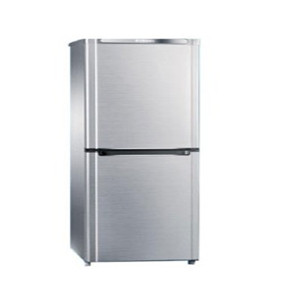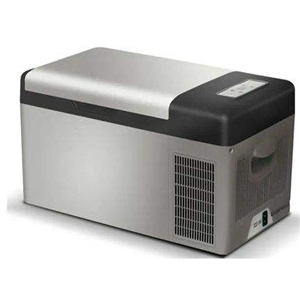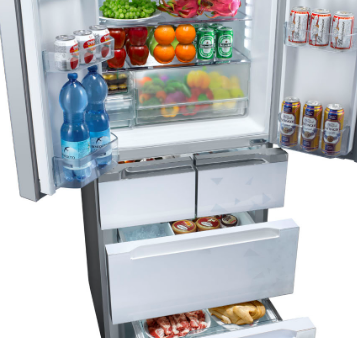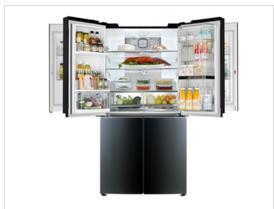Why the refrigerator frosts
Living at home requires a refrigerator. The inner wall of the refrigerator frosts. Where does the moisture come from?
It is understood that most of the water vapor comes from the air. When people open the refrigerator to store food, the indoor air and the gas in the refrigerator exchange freely, and the indoor wet air quietly enters the refrigerator. Another part of the water vapor comes from the food stored in the refrigerator. For example, clean vegetables and fruits are put in the fresh-keeping box, and the water in vegetables and other food evaporates and becomes frost when it is cold. Especially in summer, the indoor temperature is high, the humidity is high, and the difference between the room temperature and the temperature in the refrigerator is large. When the refrigerator is opened, a stream of cool air flows from the inside to the outside, and indoor air drills into the refrigerator. In a little time, a layer of white frost condenses on the wall of the refrigerator. It is also found that even if nothing is put in the refrigerator, a thick layer of frost will form in the refrigerator that is often opened. It can be seen that a large part of the moisture in the refrigerator comes from the moisture in the air.
How to Defrost Refrigerators
Some refrigerators need defrosting. Manual defrosting is time-consuming and laborious, and the defrosting effect is very poor. Here is a tip for defrosting.
According to the size of the refrigerator freezer, cut a slightly thick plastic film and stick it on the frosted wall of the refrigerator without using any glue. When defrosting, take out the food in the refrigerator temporarily, remove the plastic film and shake it for a while, then the frost will fall off completely, and then paste a new film, put the food in, and continue to use.
How to save energy in refrigerators
1、 Keep away from heat source and maintain clearance
When the temperature around the refrigerator increases by 5 ℃, its internal power consumption will increase by 25%. Therefore, it should be placed as far away from heat sources as possible, preferably in a ventilated and shady place. Do not put hot food directly into the refrigerator, and put it in when it reaches room temperature. The food in the freezer is packaged in small plastic bags, which can be frozen quickly, not only not easy to dry, but also prevent moisture from turning into frost; The food should not be too full, and a gap should be left between the food and the refrigerator wall to facilitate the flow of cold air; The frozen food should be transferred to the refrigerator for thawing in a planned way before eating.
2、 Do not open the door frequently
If the door is opened too frequently, on the one hand, the power consumption of the refrigerator will increase significantly, and on the other hand, the service life of the refrigerator will be reduced. Because the door of the refrigerator is large, if the door is opened more times, the cold air in the box will escape, and the warm and humid air outside the box will take the opportunity to enter, which will increase the temperature in the box. At the same time, the moist air entering the box is easy to speed up the frosting on the evaporator surface and thicken the frosting layer. Since the thermal conductivity of frost is much smaller than that of evaporator material, it is not conducive to heat conduction, resulting in slow temperature drop in the box, increased compressor working time, accelerated wear, and increased power consumption. If the thickness of the frosting layer on the evaporator surface is greater than 10 mm, the heat transfer efficiency will drop by more than 30%, resulting in a significant reduction in the refrigeration efficiency. In addition, when the door of the box is opened, the lights in the box will be turned on, which consumes electricity and dissipates heat, obviously not conducive to energy conservation.
3、 Power off for fresh-keeping and off peak power consumption
If you are worried about the "power shortage" caused by the peak power consumption, we suggest you use the Rongsheng refrigerator developed by Hisense Kelon, which has the function of "electricity sharing, power-off and fresh-keeping". The refrigerator can still cool and keep fresh when the power is cut off for 20 hours; In addition, its "electricity hour meter" function can avoid refrigeration in the peak hours of electricity consumption with high prices, and automatically realize "peak load shifting".
Taking Beijing as an example, if the electricity price from 22:00 p.m. to 8:00 a.m. the next day is a quarter of the peak electricity price, consumers can input the information of the low hours from 22:00 p.m. to 8:00 a.m. into the refrigerator computer control panel. In this way, the refrigeration system of the refrigerator will automatically start at 22pm for refrigeration and cold storage. When the electricity price rises at 8am, the battery will drive the micro fan to blow the cold capacity of the cooler to the food in the refrigerator, so as to make full use of the low price valley electricity and avoid the expensive peak electricity.
4、 Precautions
The use rate of refrigerators is higher when the weather starts to get hot. But you should know that refrigerators can only extend the limit of food storage, and are not foolproof "safes". If it exceeds a certain period of time, all kinds of food stored in the refrigerator will lose their original delicious taste and nutrients. Because some bacteria and viruses may have been brought into the food when it was put into the refrigerator, the temperature of the refrigerator is not zero, and many bacteria can be hidden in the low temperature environment, waiting for a long time will wait for the opportunity to multiply in large numbers, making trouble, and making the preserved food moldy, corrupt and deteriorated. Therefore, the following preventive measures must be taken:
1. The food put into the refrigerator must be clean and clean. Wash and drain fruits, vegetables and other raw foods before putting them in. Raw fish, chickens and ducks can be put into the refrigerator only after the viscera are removed and the water is washed.
2. After one to two weeks of use, the refrigerator should be wiped once or twice with a soft cloth soaked in warm water. Do not use detergent, detergent or gasoline.
3. Raw food and cooked food shall not be stored in the same container, and raw vegetables and fruits shall not contact with raw meat, fish, etc. to prevent bacterial pollution.
4. There should be a certain gap between the food placed in the refrigerator, and it should not be close to the left, right and back walls of the refrigerator, so as to facilitate the convection of cold air. The contents of the refrigerator should not be too full.
5. Try to reduce the time and times of opening the refrigerator door to reduce the entrance of external hot gas. The author realized that the food in the refrigerator should not be kept for more than five to seven days, and the food taken out should not be eaten again if it is found to be moldy, putrid and stale.
6. In hot summer, cold drinks, frozen drinks, fruits, food, etc. taken out of the refrigerator should be stored at room temperature before eating, to avoid sudden stimulation of cold drinks causing stomach pain, enteritis, diarrhea, or aggravating the original hypertension, coronary heart disease, stroke and other diseases, especially the elderly and children.
7. The placement of refrigerators is also particular, and the following two issues should be paid attention to generally:
When placing the refrigerator, a space of 5-10cm should be reserved on both sides, 10cm above and 10cm behind to help cool the refrigerator. Do not put it together with audio, TV, microwave oven and other appliances. The heat generated by these appliances will increase the power consumption of the refrigerator.






